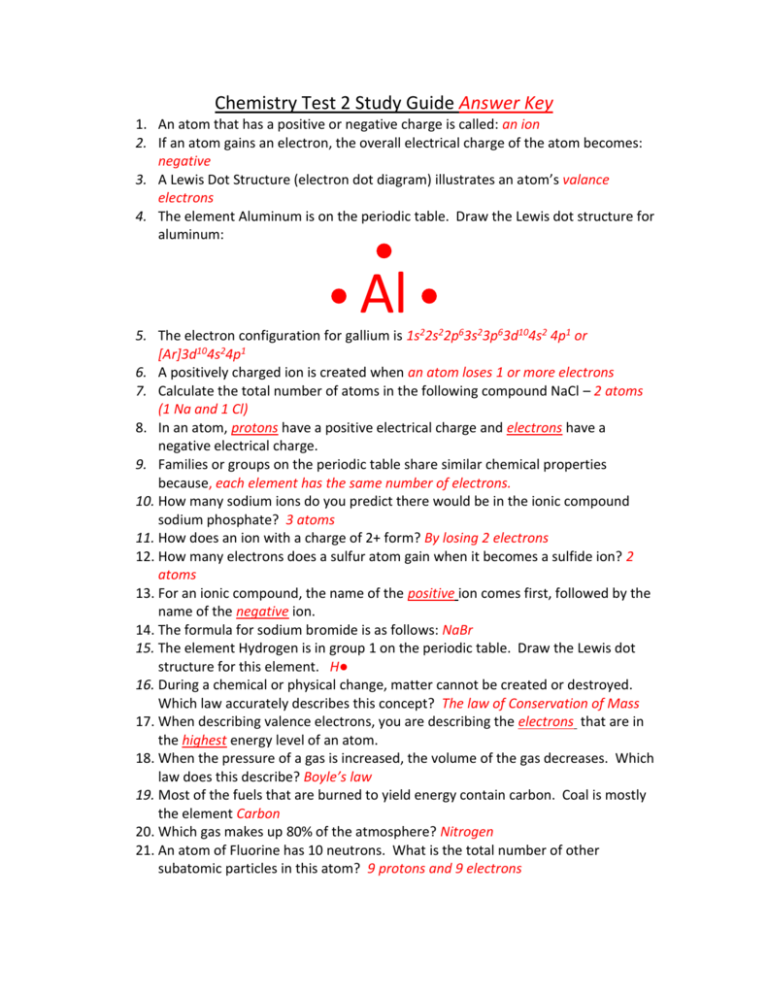An atom that has a positive or negative charge is called: an ion
advertisement

Chemistry Test 2 Study Guide Answer Key 1. An atom that has a positive or negative charge is called: an ion 2. If an atom gains an electron, the overall electrical charge of the atom becomes: negative 3. A Lewis Dot Structure (electron dot diagram) illustrates an atom’s valance electrons 4. The element Aluminum is on the periodic table. Draw the Lewis dot structure for aluminum: Al 5. The electron configuration for gallium is 1s22s22p63s23p63d104s2 4p1 or [Ar]3d104s24p1 6. A positively charged ion is created when an atom loses 1 or more electrons 7. Calculate the total number of atoms in the following compound NaCl – 2 atoms (1 Na and 1 Cl) 8. In an atom, protons have a positive electrical charge and electrons have a negative electrical charge. 9. Families or groups on the periodic table share similar chemical properties because, each element has the same number of electrons. 10. How many sodium ions do you predict there would be in the ionic compound sodium phosphate? 3 atoms 11. How does an ion with a charge of 2+ form? By losing 2 electrons 12. How many electrons does a sulfur atom gain when it becomes a sulfide ion? 2 atoms 13. For an ionic compound, the name of the positive ion comes first, followed by the name of the negative ion. 14. The formula for sodium bromide is as follows: NaBr 15. The element Hydrogen is in group 1 on the periodic table. Draw the Lewis dot structure for this element. H● 16. During a chemical or physical change, matter cannot be created or destroyed. Which law accurately describes this concept? The law of Conservation of Mass 17. When describing valence electrons, you are describing the electrons that are in the highest energy level of an atom. 18. When the pressure of a gas is increased, the volume of the gas decreases. Which law does this describe? Boyle’s law 19. Most of the fuels that are burned to yield energy contain carbon. Coal is mostly the element Carbon 20. Which gas makes up 80% of the atmosphere? Nitrogen 21. An atom of Fluorine has 10 neutrons. What is the total number of other subatomic particles in this atom? 9 protons and 9 electrons 22. How many electrons can an orbital hold? A number of electrons that depends on the energy level. 23. Unstable atomic nuclei that release fast-moving particles and energy are called isotopes 24. A covalent bond in which electrons are shared unequally is a Polar Bond 25. How many electrons are shared in a single covalent bond? 1 electron 26. In the following answers, the first number represents the mass number of an atom; the second number represents the atomic number of the same atom. Which atom will have the greatest number of electrons? 56, 25 27. What does Dalton’s theory state? All matter is made of atoms. 28. What does Rutherford’s theory state? The atom consisted of subatomic particles called protons and electrons. 29. Which subatomic particles are most directly involved in chemical bonding? Valance electrons. 30. The figure below shows a periodic table with the position of one element indicated by an X. How would this element (X) be classified? Non-metal





